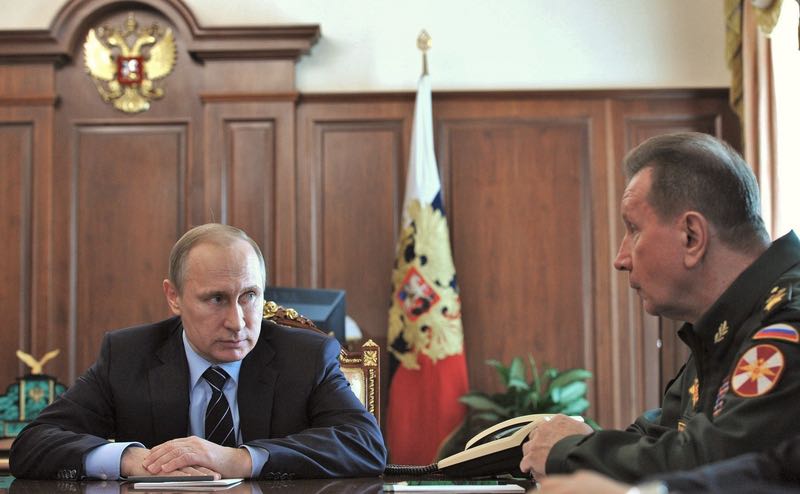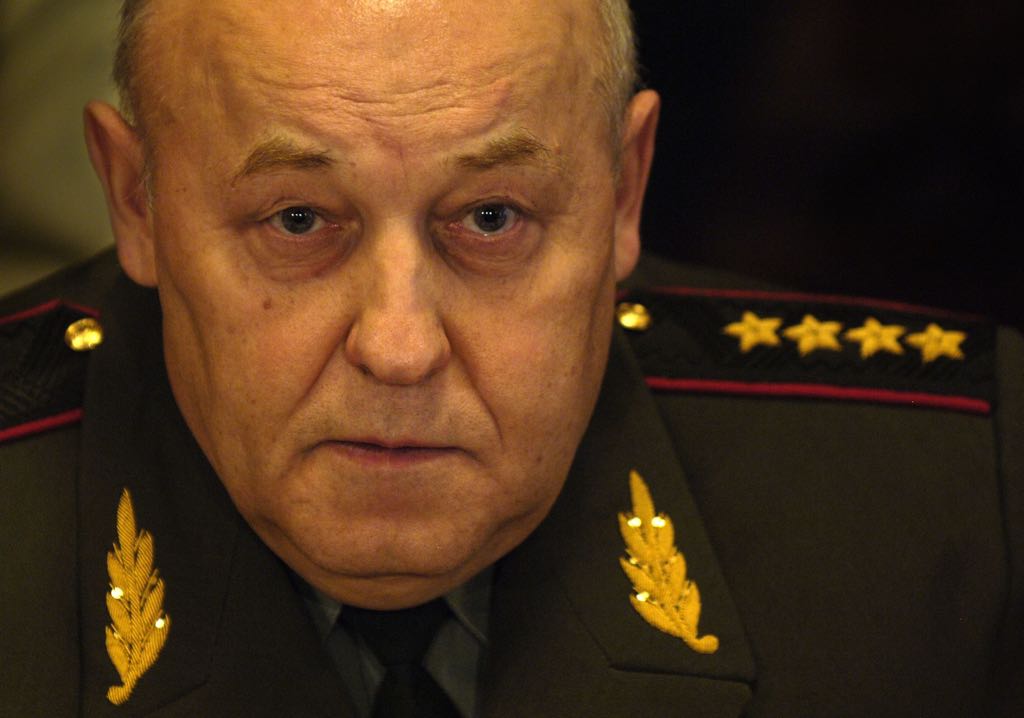Putin's creation of a National Guard, in 2016, is the most striking reform of law-enforcement agencies of the last decade. In case of unrest the army can be placed under its command. Historian Igor Torbakov explains how the Kremlin is preparing to prevent a potential ‘color revolution’ in Russia.
As the crisis in relations between Russia and the West deepens, the Kremlin’s threat assessments appear to have grown more alarmist. Simultaneously, a highly personalized political regime forged over president Putin’s seventeen-year long rule has prompted Kremlin strategists to directly identify Russia’s national interest with that of its supreme leader. Growing authoritarianism and threat perceptions shaped by both external pressure and the specter of domestic unrest are behind the decision to massively overhaul Russia’s sprawling law enforcement and security apparatus.
‘Western politicians do not understand the essence of Russia and its basic principles,’ lamented Vyacheslav Volodin, Putin’s deputy chief of staff, in his remarks at one of the closed sessions of the Valdai Club, a discussion platform bringing together Russia’s top policymakers and Western opinion makers, in late October 2014. The thing is, he went on, that Russian people perceive Western criticism of Russian president as a direct attack against their country. Volodin concluded his presentation with a seemingly preposterous suggestion: ‘If there’s Putin there’s Russia. If there’s no Putin there’s no Russia.’
No matter how ridiculous this statement appears to be, it would be unwise to simply dismiss it as a farcical effort on the part of a Kremlin courtier to suck up to his boss. It would appear that Volodin’s political imaginary whereby Putin is cast as a physical embodiment of Russia is shared widely among broad segments of the Russian policy elite. More important, it seems to be shared by Putin himself who came to see his own destiny and that of Russia as tightly intertwined.
This optical view is bound to blur the lines between Russia’s national security and the security of its leader. In Russia, the border between protecting the public good and safeguarding the present-day political regime and the person who presides over it became ominously vague with the Kremlin’s decision to create the Rosgvardiya – Russia’s National Guard.
Separate army in its own right
On April 5, 2016, Putin signed Executive Order no. 157 ‘On the Federal National Guard Service of the Russian Federation.’ According to this presidential decree ‘the internal forces of the Ministry of Interior Affairs of the Russian Federation shall be transformed into troops of the National Guard, that will be part of the Federal National Guard Service of the Russian Federation.’ On the same day Putin appointed Viktor Zolotov as director of the Federal National Guard Service and Commander of the troops of the National Guard, reporting directly to him.
At first sight the move seemed to be a kind of routine reorganization. In fact, this was Russia’s biggest and potentially most consequential reform of law-enforcement agencies over the last decade. There is much more to these two decrees than initially meets the eye. First, with its 170 000 former Ministry of Interior troops, reinforced with the units of riot police, special-forces and police security guards, the newly formed National Guard constitutes a separate army in its own right.
Second, the appointment of general Zolotov as its commander is highly significant. Zolotov used to be Putin’s bodyguard and then served as longstanding head of the presidential secret service, a subdivision of the Federal Defense Service (FSO). That Zolotov was promoted to become commander of the troops of the ministry of Interior in 2013 suggests that the ambitious law-enforcement reform has long been in the making.

National Guard commander Viktor Zolotov (right) and president Putin. Photo Wikimedia
Under Zolotov’s command, the troops of the ministry of Interior have undergone a thorough revamp: since 2013, the number of servicemen on contract basis rose dramatically, while the number of those who were drafted was scaled down to 10 percent. Since its creation the National Guard thus became the most professional military structure whose strength is roughly comparable with Russia’s land forces, with its units deployed in all of Russia’s seven military districts.
Power vertical completed
Finally, it is very symbolic that the formidable new security service is headed by a former bodyguard. Russian commentators have highlighted the difference in training and modus operandi between Russia’s other siloviki (military top brass, police officers, and spymasters) and the members of the new security service in detail. While the former are trained to protect the state and are supposed to be guided by raison d’état, the latter are solely focused on the physical security of the person they are assigned to protect. With the creation of the National Guard, the construction of Putin’s ‘security vertical’ appears to have been completed. The Russian president can now rely on a fearsome military machine headed by an individual who is unquestionably loyal to him.
In late may, Rosgvardiya’s command reported that the number of its servicemen was twice as big as that of the former ministry of Interior troops. According to the estimate of Alexander Golts, a highly respected Moscow-based military analyst, this means that its overall strength is now something between 360 000 ‑ 380 000 men, which exceeds the number of troops of the regular army.
At the same time another decree was signed, stating that ‘units and military formations of the Armed Forces of the Russian Federation, other military formations and services can be transferred to the operational subordination of the district commander [of the National Guard] to carry out the tasks assigned to the National Guard troops.’ The upshot of this consequential move is crystal clear: if need be, the National Guard will be reinforced by the Armed Forces units. Significantly, if this ever takes place, it is the latter that will be subordinated to the former.

General Yury Baluyevski, former Chief of Staff and top aide of general Zolotov. Photo Wikimedia
Maidan-lesson: threats from inside
Following the publication of this decree the military magazine Nezavisimoe Voennoe Obozrenie (Independent Military Review) on may 26 published a wide-ranging programmatic article by Yury Baluyevsky, former chief of the Russian General Staff and currently Zolotov’s top aide. This remarkable document unambiguously explains the reasons behind the Russian leadership’s decision to create Rosgvardiya.
General Baluyevsky states that ‘the goal of wars in the 21st century will not be the seizure of territories, but the subordination of the state apparatus and the formation of a system of external governance over peoples residing on these territories’. He then grimly notes that ‘in the late 20th - early 21st centuries, more than 30 color revolutions took place. They brought nothing positive to the peoples of those countries that were subjected to the monstrous experiments of transatlantic strategists.’
Baluyevsky goes on to point out that Western military planners consider fomenting domestic nonviolent protests in the enemy’s territory as a legitimate type of warfare. ‘If this is so,’ he argued, ‘then it is also necessary to defend ourselves against mass riots in the streets of our cities and see such defense in terms of war. The coup d’état in Kiev [in February 2014], of course, became one of the reasons for the creation of the troops of the National Guard in Russia… The emergence of the National Guard is the answer to the challenge to our society, to the threat posed by the technology of so-called non-violent resistance, which nevertheless is more accurately called a color revolution.’
With an amazing bluntness, general Baluyevsky thus states that Rosgvardiya’s ultimate objective is to suppress domestic unrest. ‘The centuries-old history has proved that Russia cannot be defeated from the outside,’ he contended. ‘The main threats to Russia may lie not outside it, but inside. We must be prepared to prevent threats from within.’
Faux pas?
It seems that when creating the National Guard the Kremlin leader took a leaf out of a history book on ancient Rome. In the imperial period, the Praetorian Guard (cohorts praetoriae) constituted an elite force assigned to protect the emperor. In the run up to Russia’s potentially turbulent electoral cycle in 2018, Putin appears to have decided to take no risks. Yet if history is any guidance at all, the Kremlin ‘emperor’ may well have committed a faux pas: in imperial Rome a number of emperors were murdered with involvement of the Praetorian Guard. This was the sad irony of ancient Roman history: the body specifically created to protect the emperor’s person had become his greatest liability.
Originally published by Utrikes Magasinet
